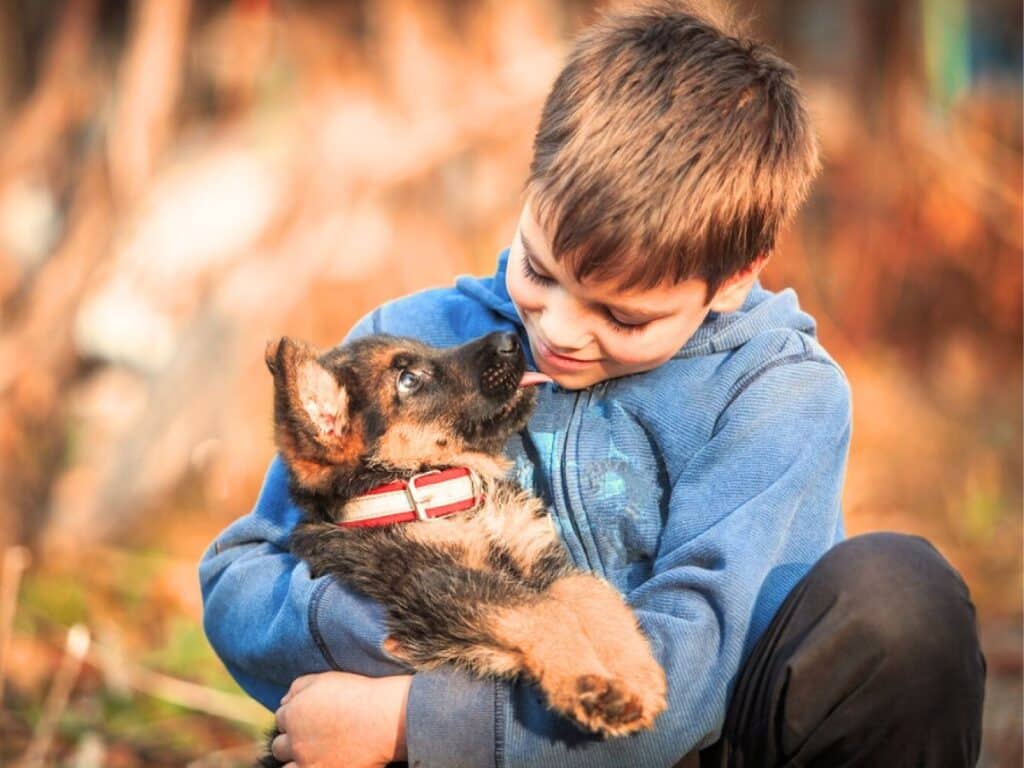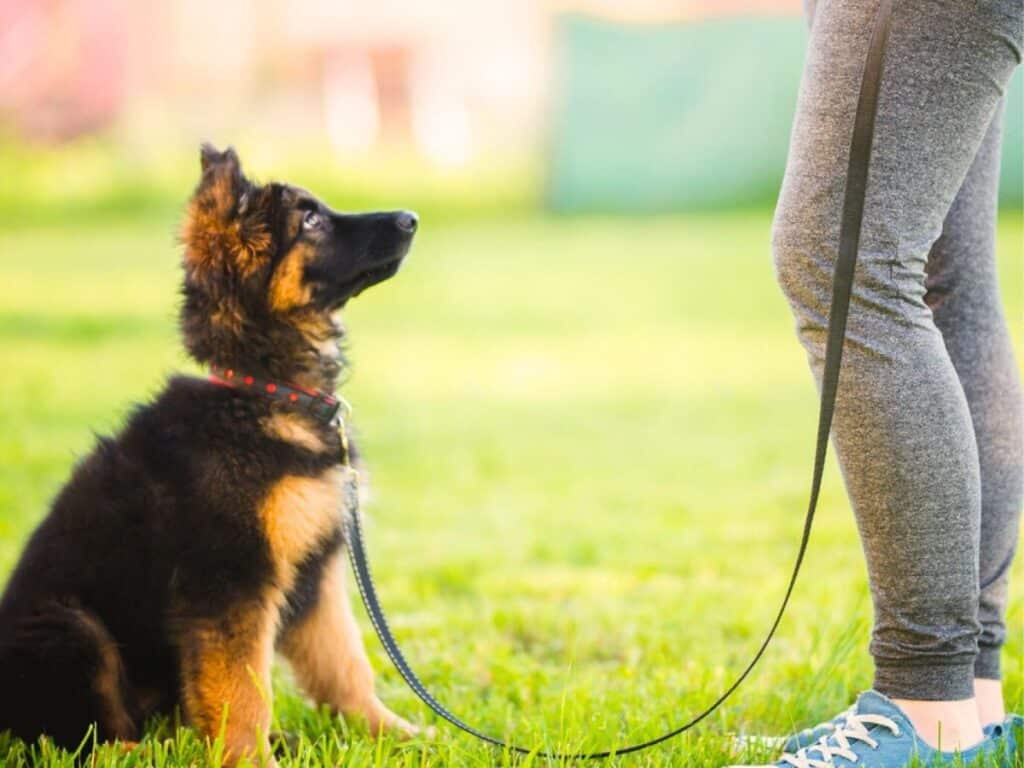Hey there! Thinking about crate training your German Shepherd puppy? Great call!
When used correctly, crates become a cozy retreat where your furry friend can relax, sleep, and feel secure.
So, in this guide, I’ll outline a step-by-step approach to crate training, ensuring a positive experience for both you and your German Shepherd as embark on this essential aspect of their development.
Should German Shepherds Be Crate Trained?
Yes, German Shepherds should be crate trained. Crate training can be beneficial for both the dog and the owner.
- It provides a safe and secure space for the dog, similar to a den, where they can feel comfortable and relaxed.
- Crate training can help with housebreaking and preventing destructive behavior when left unsupervised.
- Crate training even helps with separation anxiety. Also, crate training can make traveling and vet visits easier.
Dogs who are accustomed to being in a crate are more likely to feel calm and relaxed during car rides or when confined at the vet’s office.
But, it’s important that crate training should be done properly and humanely.
German Shepherd Crate Training: Don’t’s
Crate training your German Shepherd can be valuable in teaching him good behavior and providing a safe and comfortable space. However, if a crate is used incorrectly, a dog can feel trapped and frustrated.

Here are a few cautions to keep in mind when crate-training your puppy:
Don’t use the crate as a punishment for bad behavior. You want to associate the crate with only good things so your dog is happy to use the crate.
Don’t leave your puppy in the crate for extended periods. Puppies have limited bladder control, and leaving them in the crate for too long can lead to accidents and discomfort. A general guideline is that puppies can hold their bladder for roughly one hour for every month of age, up to a maximum of about 4-6 hours.
Don’t leave your puppy in a crate for more than three or four hours if he is under 6 months of age.
Don’t force your puppy into the crate. Allow your puppy to explore the crate voluntarily. Forcing them into the crate can create anxiety and make them resistant to using it.
Don’t rush crate training. Sometimes, it can take six months of consistent training.
Remove collars, harnesses, and anything that could pose a choking hazard or cause injury while your puppy is in the crate.
Don’t use the crate as the only form of confinement. While the crate is a useful tool, your puppy should also learn to behave appropriately in other areas of your home.
Now that we’ve addressed the dangers of using the crate incorrectly, let’s discuss how to crate train a German Shepherd puppy.
German Shepherd Puppy Crate Training: Step-by-Step Guide
Step 1 – Introduce Your Puppy to the Crate

Begin by placing the crate in an area where your puppy spends most of their time. Leave the door open and make it inviting by adding a soft blanket or bedding inside.
To encourage your puppy to explore the crate, place treats or toys near the entrance, then just inside the door, and finally, all the way inside the crate.
Allow them to approach and investigate at their own pace.
Avoid forcing them into the crate as this may create negative associations.
Once your puppy is comfortable approaching and entering the crate voluntarily, praise them and offer a treat as a reward.
Repeat this step 2 – 3 times a day for not more than 5 – 10 minutes each time. This step may take a few minutes or as long as several days. So be patient.
Step 2 – Feed Your Puppy Meals in the Crate
Once your pup has voluntarily explored the crate, invite them in by placing their meal inside with the door open.

If your puppy is comfortable in the crate, you can place the food dish at the back of the crate.
But if your puppy is still reluctant to go inside, only place the food as far as he feels comfortable entering the crate.
Each time you feed him, place the dish a little further back in the crate.
Repeat this a few times during meals to reinforce that the crate is a cozy and secure spot.
Once they’re comfortable eating in the crate, gently start closing the door while they eat. Always open it as soon as their meal is finished.
With each successive feeding, leave the door closed a few minutes longer, until he’s staying in the crate for 10 minutes or so after eating.
If your pup starts to whine, it means you may have increased the time too quickly.
Next time, shorten the duration and only let them out when they’re quiet for 10 to 30 seconds. Otherwise, he’ll learn that the way to get out of the crate is to whine, so he’ll keep doing it.
Step 3 – Condition Your Pup With Longer Crating Periods
Once your pup seems comfortable with the crate and is regularly eating his meals inside, you can gradually increase the time your pup spends in the crate, while you are around.

Teach them a command, like “crate,” or “kennel up”, close the door, and reward them with a treat when they enter on command.
If your pup is still reluctant, encourage him by pointing to the inside of the crate with a treat in your hand.
Sit quietly near the crate with the door closed for 5 to 10 minutes. Drop treats occasionally to keep it positive.
Then go into another room for 5 – 10 minutes. Return, sit quietly again for a short time, then let him out of the crate. Repeat this process 3 – 4 times a day.
With each repetition, gradually increase the length of time you leave him in the crate and the length of time you’re out of his sight.
Once they’re okay with 30 minutes, start leaving them in the crate when you leave the house for short time periods. This may take several days or several weeks.
Step 4 – Crate Your GSD Pup When You Leave Home

After your dog is used to spending about 30 minutes in the crate without becoming anxious or afraid, practice leaving the house for a short time while your pup is in the crate.
Use the same steps as before, calmly calling them to the crate and rewarding them.
Make sure not to crate your pup for a long time before you leave, you can crate him anywhere from five to 20 minutes before leaving.
When it’s time to leave, keep it low-key. Don’t make a big fuss or get overly affectionate, as this might make them anxious about your departure.
Instruct him to go into the crate, reward them, and offer praise. Leave without making a big deal out of it.
When you return, quietly let him out of the crate. Don’t reward your dog for excited behavior by responding to him in an excited, enthusiastic way.
Sometimes, crate your dog for short periods (2 – 3 hours) even when you’re home. This helps them not associate the crate with only long departures.
RELATED: German Shepherd Behavior Stages By Age
Step 5 – Crate Training German Shepherd Puppy at Night

When your puppy feels at ease in the crate, it’s time to begin crating him during the night.
Keep in mind that puppies often need to relieve themselves during the night and will cry to let you know. So, it can be useful to have the crate in your bedroom at night so that you can hear their cries for the bathroom.
Puppies may whine when they are initially placed in the crate, but these whines usually stem from feeling anxious. However, if they cry during the night, it is usually a sign that they need to go outside to relieve themselves.
It can be useful to have the crate in your bedroom as it allows your puppy to smell you and not feel alone. This is also beneficial for older dogs undergoing crate training.
Once your puppy starts feeling more at ease spending the night in the crate, you can slowly start keeping the crate at the spot in your house that you prefer.
Choosing a Crate For Your German Shepherd Puppy

When choosing a crate for your GSD, it’s important to consider various factors to ensure the crate meets your dog’s needs and is suitable for your specific situation.
Here are some factors to consider when choosing a crate:
- What is the size of my dog?
- Consider the current size of your dog and estimate their potential adult size if you’re getting a crate for a puppy.
- What is the purpose of the crate?
- Is it for house training, travel, or providing a safe space at home? The purpose can affect the type and design of the crate you choose.
- Is the crate easy to clean?
- Look for crates with removable trays or easily cleanable surfaces to make maintenance and cleaning more convenient.
- Does the crate have a divider panel?
- Dividers are useful for adjusting the size of the crate for a growing puppy, allowing you to expand the space as needed.
- Is it collapsible or portable?
- Consider whether you need a crate that is easy to transport or store, especially if you plan to travel with your German Shepherd.
- What is the crate made of?
- Check the material of the crate. Common materials include wire, plastic, and fabric. Each has its advantages and disadvantages in terms of durability, weight, and visibility.
- Does the crate have secure latches or locks?
- Ensure that the crate has sturdy and secure latches to prevent your dog from accidentally escaping.
- Does the crate have safety features?
- Look for features like rounded edges to prevent injury, non-toxic materials, and overall design to ensure your dog’s safety.
- Is there enough room for your dog to stand, turn around, and lie down comfortably?
- However, it should not be too large, as puppies are less likely to use a crate as a bathroom if it’s appropriately sized.
Always consider your dog’s individual needs and preferences when selecting a crate.
What size crate is suitable for a German Shepherd puppy?
For a German Shepherd puppy, you can start with a crate that is around 36 inches (91 cm) in length. This size should accommodate your puppy’s needs during the early months.
As your puppy grows, you may need to upgrade to a larger crate to ensure they have enough space.
German Shepherds are a large breed, and as adults, they typically require larger crates, such as 42 inches (107 cm) or even 48 inches (122 cm), depending on the individual dog’s size.

How Long Can a German Shepherd Be in a Crate?
On average, an adult German Shepherd can be crated for about 4 to 6 hours at a time. Puppies have smaller bladders, so they should not be crated for more than 2 to 3 hours (or fewer if they are 8 to 12 weeks old) at a time.
Leaving a German Shepherd in a crate for extended periods without proper exercise and mental stimulation can lead to boredom, anxiety, and behavioral problems.
Therefore, it is crucial to strike a balance between crate time and free time to ensure the well-being of your German Shepherd.
Dogs with health issues or senior dogs may have different needs. If you work long hours, consider having someone come in to let your dog out or hiring a dog walker.
RELATED: Can German Shepherds Be Left Alone?
Benefits of Crate Training Your German Shepherd Puppy
Crate training your German Shepherd puppy can have numerous benefits for both you and your furry friend. Here are some of the key advantages:
Housebreaking
By confining them to a crate when you’re unable to supervise, you can prevent accidents in the house. Dogs have a natural instinct to keep their sleeping area clean, so they are less likely to eliminate in their crate.
RELATED: How To Potty Train a German Shepherd Puppy
Safety and Security
A crate provides a safe and secure space for your puppy. It becomes their den, a place where they can feel protected and comfortable. It also prevents them from getting into trouble or potentially dangerous situations when you’re unable to watch them.

Travel Safety
Whether you’re going on a road trip or flying, having a crate-trained dog ensures they have a familiar and secure space during the journey. It also helps prevent them from becoming anxious or stressed in unfamiliar environments.
Preventing Destructive Behavior
Crate training can help prevent destructive behavior, such as chewing on furniture or belongings when you’re not able to provide direct supervision.
Giving them a safe space with appropriate toys and chews can positively redirect their energy.
Facilitating Training
Using a crate as part of your training routine can make it easier to teach your German Shepherd puppy commands and house rules. It helps establish boundaries and reinforces positive behaviors.
For example, you can use the crate as a reward for good behavior or as a time-out space for undesirable behaviors.
RELATED:
Promoting Independence
Crate training encourages independence in your German Shepherd puppy. According to paws.org, it teaches them to be comfortable spending time alone and prevents separation anxiety.
RELATED: How To Help Your GSD Overcome Separation Anxiety
Facilitation of Routine Vet Visits
Dogs that are comfortable in crates are typically easier to manage during vet visits. It can reduce stress for both you and your dog when they are familiar with being confined in a crate.
RELATED: Common German Shepherd Health Issues

How To Deal With Puppy’s Whining When Crate Training?
Remember that there’s a difference between “frustration” noises and “I gotta go” noises. If you’ve just returned from a potty trip, a dog whining in the crate for the first few minutes is likely just settling in.
If you’re convinced that your dog doesn’t need to eliminate, the best response is to ignore him until he stops whining.
If your dog is just testing you, he’ll probably stop whining soon. Don’t give in, otherwise, you’ll teach your dog to whine loudly to get what he wants. (Source)
RELATED: Why Do German Shepherds Whine So Much?
German Shepherd Puppy Crate Training Schedule

Here’s a sample crate training schedule for your puppy, starting at 7 am. Keep in mind that individual puppies may have different needs and energy levels, so feel free to adjust the schedule based on your schedule and your puppy’s specific requirements.
| Time | Event | Activity |
|---|---|---|
| 07:00 am | Wake Up and Bathroom Break | Offer first meal along with crate training. Take the puppy outside for a bathroom break 10-30 minutes after eating. Return to crate, sit with them, and reward calm behavior. |
| 07:30 am – 08:30 am | First Meal and Crate Training | Take the puppy outside for another bathroom break. Spend time indoors bonding and playing with toys. Get the whole family involved. |
| 10:30 am | Morning Bonding | Supervise the puppy’s second meal. Take puppy outside for a bathroom break 10-30 minutes after eating. |
| 12:00 pm | Midday Meal | Take puppy outside for a bathroom break and exercise. Return to crate, sit with them, and reward calm behavior. |
| 14:00 pm – 14:30 pm | Afternoon Crate Training | Take the puppy outside for a final bathroom break. Put the puppy to bed in their crate, close the door, and ignore the whining. Make a “tsst” noise until calm, then reward with a treat. |
| 17:00 pm | Evening Meal and Bonding | Take the puppy outside for a bathroom break and exercise. Return to crate, sit with them, and reward calm behavior. |
| 19:00 pm – 19:30 pm | Evening Crate Training | Supervise the puppy’s second meal. Take the puppy outside for a bathroom break 10-30 minutes after eating. |
| 21:00 pm – 22:00 pm | Bedtime | Take the puppy outside for play and exercise. Return to crate, sit with them, and reward calm behavior. |
Conclusion
By following the step-by-step process outlined in this article, you are well on your way to successfully crate training your German Shepherd puppy. Remember, crate training is not only beneficial for housebreaking and preventing destructive behaviors but also provides a safe and comfortable space for your puppy to relax and feel secure.
So go ahead, embark on this exciting journey with your puppy, and enjoy the countless benefits of crate training. Before you know it, your furry friend will be happily resting in their crate, giving you peace of mind and a well-behaved companion.
Frequently Asked Questions (FAQs)
1. How long does it take to crate train a puppy?
Crate training duration varies depending on the puppy’s age, temperament, and previous experiences. It can take anywhere from a few days to several weeks for your puppy to become comfortable with the crate.
2. Should German Shepherd puppies sleep in a crate?
Yes, it’s generally recommended for German Shepherd puppies to sleep in a crate as it provides a secure and controlled environment, aiding in house training and preventing nighttime accidents.
3. When should I stop crate training my German Shepherd?
You can consider stopping crate training for your German Shepherd once they consistently demonstrate good behavior, reliable house training, and no longer have destructive tendencies. This varies but often occurs around 1 to 2 years of age.




